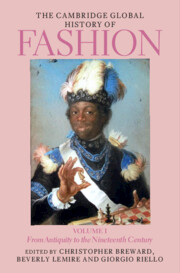Book contents
- The Cambridge Global History of Fashion
- The Cambridge Global History of Fashion
- The Cambridge Global History of Fashion
- Copyright page
- Contents for Volume I
- Figures for Volume I
- Maps for Volume I
- Table for Volume I
- Contributors for Volume I
- Preface
- 1 Global History in the History of Fashion
- Part I Multiple Origins of Fashion
- Part II Early Modern Global Entanglements
- 7 Magnificence at the Royal Courts in the Islamic World
- 8 Early Modern Fashion Cities
- 9 Fashioning Possibilities
- 10 Fashion Beyond Clothing
- 11 Fashion and the Maritime Empires
- 12 Garments of Servitude, Fabrics of Freedom
- Part III Many Worlds of Fashion
- Index
- References
8 - Early Modern Fashion Cities
Italy and Europe in a Global Context
from Part II - Early Modern Global Entanglements
Published online by Cambridge University Press: 04 August 2023
- The Cambridge Global History of Fashion
- The Cambridge Global History of Fashion
- The Cambridge Global History of Fashion
- Copyright page
- Contents for Volume I
- Figures for Volume I
- Maps for Volume I
- Table for Volume I
- Contributors for Volume I
- Preface
- 1 Global History in the History of Fashion
- Part I Multiple Origins of Fashion
- Part II Early Modern Global Entanglements
- 7 Magnificence at the Royal Courts in the Islamic World
- 8 Early Modern Fashion Cities
- 9 Fashioning Possibilities
- 10 Fashion Beyond Clothing
- 11 Fashion and the Maritime Empires
- 12 Garments of Servitude, Fabrics of Freedom
- Part III Many Worlds of Fashion
- Index
- References
Summary
The Italian Jesuit priest Matteo Ricci (1552–1610) was one of the founders of the Jesuit mission in China. When in China, Ricci discovered that if he presented himself dressed as a priest he was not afforded social legitimacy in elite and court society.1 So he decided to dress as a Confucian scholar, thus ‘translating’ his social position into Chinese. This reference to dress is of a piece with Ricci’s work as the first translator of the Confucian classics into Latin and of Western classics, such as Euclid’s Elements (c. 300 bce), into Chinese in collaboration with the writer, mathematician, and politician Xu Guangqi (1562–1633). As a ‘Western Confucian’, Ricci embodied a hybrid identity where dress acted as the material mediator of cultures, locations, and geographies (Figures 8.1 and 8.2).
- Type
- Chapter
- Information
- The Cambridge Global History of FashionFrom Antiquity to the Nineteenth Century, pp. 231 - 270Publisher: Cambridge University PressPrint publication year: 2023



